The best hides for Ball Pythons are those which provide a dark, snug place to sleep and rest. They need to be made from a material that’s sturdy enough to make them feel safe from predators, and ideally they should help hold in humidity. In today’s article, we’ll look at the ones that have worked best for my collection, including resin and plastic caves.
We’re going to take a look at the four best ones available in a moment. But first, check out the video below if you’d like to hear me talk about the two hides that I use and my experience with them:
What kind of hides do ball pythons like?
Ball Pythons are picky about their hides. They like them to be just right and fit a few criteria.
This is because in the wild this species spends daylight hours are hidden in a snug rodent burrow (after eating them, of course), hollowed out log, or even termite mound.
Refugia like these are special because they create a microclimate within them. They help a Ball Python avoid drying out in the sun by maintaining a higher humidity level.
At the same time, rodent burrows and termite mounds especially maintain a lower daylight temperature and higher night-time temperature, allowing the snakes to use them for thermoregulation.
Perhaps the coolest thing about rodent burrows is that they are sometimes as much as three feet (1m) deep, with a temperature gradient from top to bottom.
Obviously, in captivity, we can’t exactly reproduce this, but we should provide ideal hiding places that make the snake feel like nice it’s in a nice, secure burrow.
For a hide to be ideal it has to meet the following criteria:
- It should be snug
- Feel secure
- Be smooth on the inside
- Be dark
- Have a small entrance
- Help hold humidity
I know this sounds really specific, but by reading this article you’ll soon realise that hides that fit all of these criteria are incredibly easy to source. Some of them are even cheap!
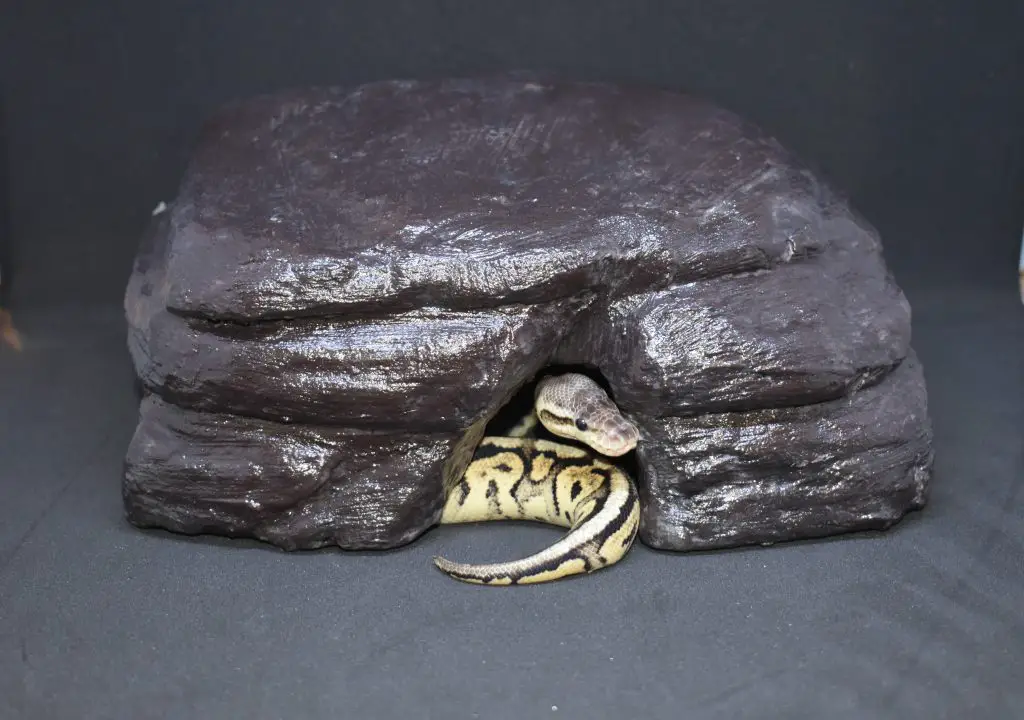
How big should a ball python hide be?
One aspect that you should pay special attention to is the size of the hide. I don’t mean the size as in diagonal measurement etc. – I mean the size of the hide in proportion to your snake.
A Ball Python hide should always be snug. That means that the inside area of the cave should be only very slightly larger than the area that your snake occupies when curled up.
This species of python is positively thigmotactic – meaning that it gains reassurance from being in contact with solid surfaces.
This behaviour is found in a lot of snakes, with some even cramming themselves into rock fissures in the wild. With Ball Pythons though, it seems to be particularly important, so much so that if they don’t have a snug hiding place many of them will stop eating.
In fact, over the past twenty years, most of the “picky” Ball Pythons people have asked me for help with have started feeding when provided with a heavy hide and smaller enclosure.
How many hides does a Ball Python need?
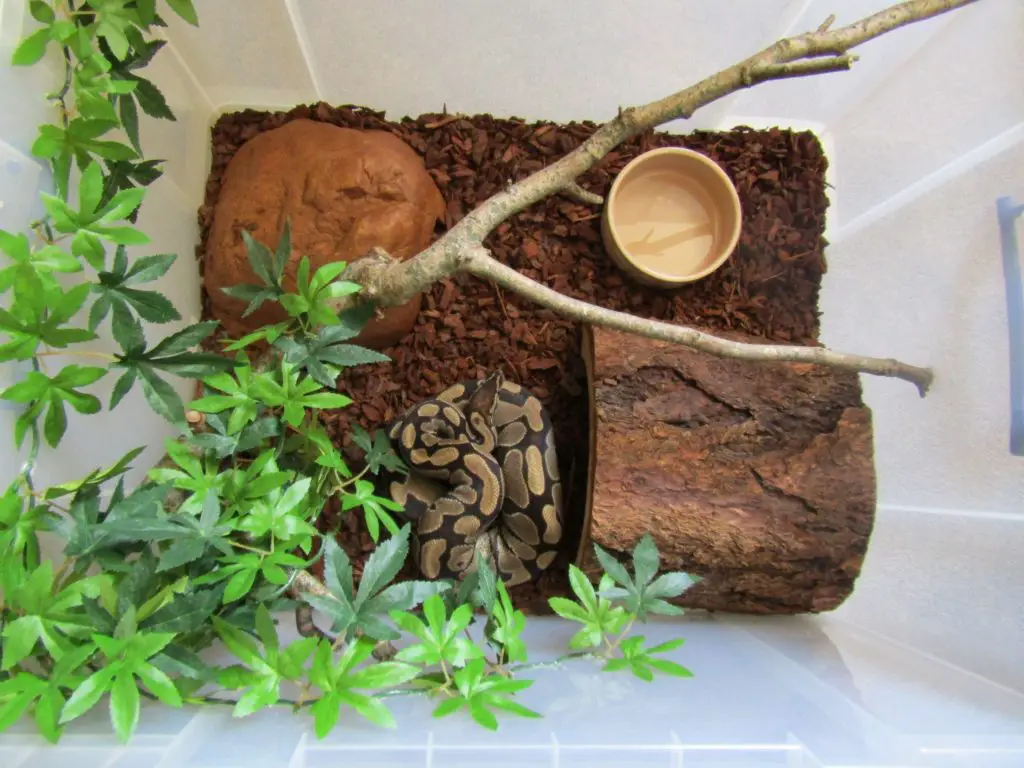
To feel safe, Ball Pythons need two hides in their enclosure. Providing one hide on the warm end and one on the cool end of the enclosure is also the best way to help your snake thermoregulate. It allows them to be comfortable at all times by choosing the temperature that suits them.
A lot of large breeders only provide their snakes with one hide. But let’s look at that situation a little more closely…
Most of those same breeders are using high-end racks with long tubs, and very reliable thermostats.
They know that their snakes can go to the front of their tub to cool down, but they still feel secure because the tub is dark and closed in by a low ceiling. This isn’t how those of us who only have one or two Ball Pythons keep them, though.
After all, why buy a $1000 or more rack to house a dozen snakes if you have no intention of becoming a breeder?
In your typical plastic tub or terrarium setup, the space inside the enclosure is greater than that in a rack tub, and this means that it’s vitally important to make your snake feel secure at both ends of the temperature gradient.
Basically, if you have a Ball Python in a tub or terrarium setup and only provide a hide on the warm end, chances are your snake will stay in the hiding place even when it feels too warm.
Add a hide to the cool end, and you’ll notice that it moves between the two, depending on its needs.
Top four best Ball Python hides
Instead of giving you the kind of sales pitch your probably used to, I’ve decided here to list the hides by broad type and brand. This way you can buy the brand I name – or choose the same kind of hide from a different brand if you find a better price.
The most important thing is that you understand why I prefer these types of hides compared to all the others. Over the years, I’ve tried all of these and have learnt what my snakes prefer – which is what really counts!
In my opinion – and my snake’s opinion – the four best hides available right now are:
- Exo Terra Reptile Caves
- Plastic hides
- Cardboard (temporary) hides
- Exo Terra Snake Cave
1. Exo Terra Reptile Caves (or similar)
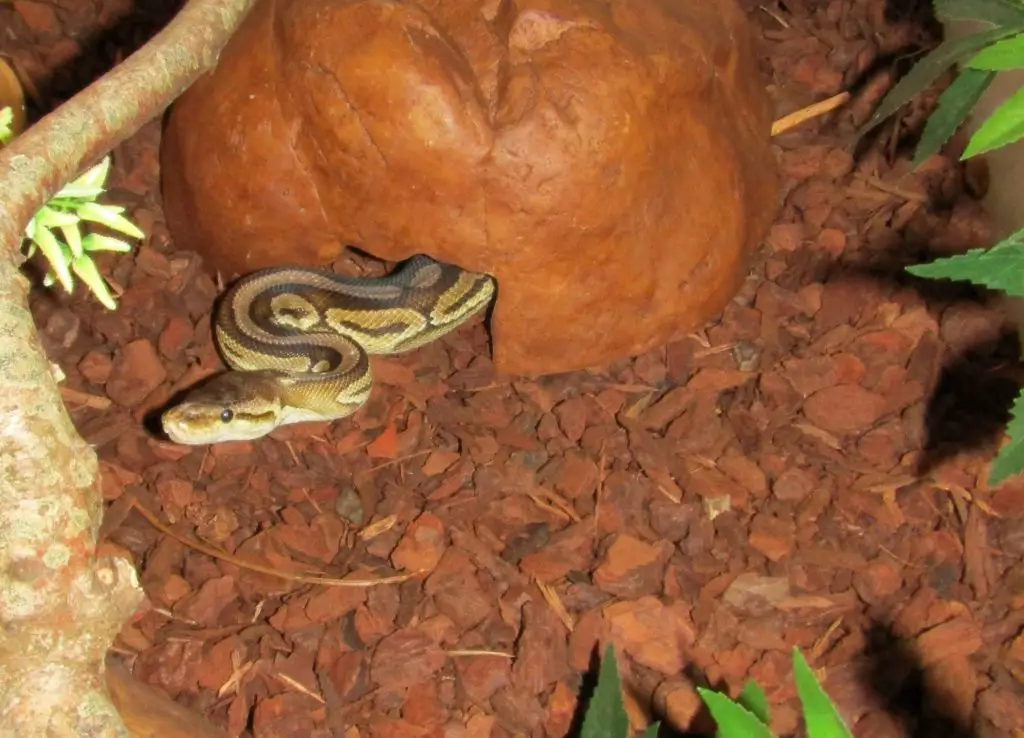
The Exo Terra Reptile Caves are my personal favourite, and every one of my snakes has one. I’ve found that these heavy, resin caves help them feel extra safe, and it turn increase their feeding response.
They also have smooth walls on the inside, which helps maintain humidity while the snake is hiding in them, something I feel helps the shedding process (don’t rely on this for maintaining humidity in the enclosure as a whole though).
Obviously, any other brand of resin caves you find will work just as well. I just prefer the Exo Terra ones because they are the most widely available and come in a good range of sizes, including XXL which is big enough for large female Ball Pythons.
| Pros: | Cons: |
| – Heavy – Attractive, naturalistic look – Help maintain humidity | – Expensive – Rough outer surface – tough to clean if urates dry onto it |
What happened when I tested them?
I first tried the Exo Terra Caves way back in 2009, and have been using them ever since. Almost immediately, I noticed that they produced the following results:
- the snakes were less restless
- the snakes ate better
- when a humidity probe was placed inside, the humidity level is roughly 10% higher than the ambient humidity in the enclosure
2. Plastic hides

Plastic hides are every bit as functional as the resin caves and come in at a lower price. Most of them also have the added bonus of having extremely smooth sides on the inside, which makes cleaning them a breeze.
Realistically speaking, this will make hygiene easier to manage if you have several snakes. Their only real downside is that they are lighter, making it easy for your snake to move them around, and probably makes them ever so slightly less secure.
| Pros: | Cons: |
| – Cheap – Very hygienic – Help maintain humidity | – Not as heavy as resin hides – Ugly (not naturalistic looking) |
What happened when I tested them?
I first tried plastic caves over 10, and have found them particularly useful for hatchlings and young snakes. When I gave them to my snakes, they produced the following results:
- the snakes were less stressed
- they ate better
- when a humidity probe was placed inside, the humidity level was roughly 5% higher than the ambient humidity in the enclosure
- subadult and adult snakes lifted them up a lot and moved them around – this isn’t great for thermoregulation as they often get moved off the warm spot
3. Cardboard (temporary) hides
Every once in a while, I’ve used a cereal box with a hole cut in it as a hide. One time, for example, I dropped one of my snakes’ resin hides and it smashed.
Between the time I smashed his cave and ordered a new one online, he was perfectly happy with a cereal box to hide in.
Obviously, this is a short-term solution: as soon as the snake goes to the bathroom the hide needs to be thrown out! When in need of a quick fix, however, you’d be surprised at how much they like this temporary option.
| Pros: | Cons: |
| – easy to find for emergencies – snakes don’t know the difference | – for temporary use only! – not sturdy |
What happened when I tested them?
I first tried cardboard hides as a kid almost 25 years ago. They were only ever a temporary solution and should not be used long-term. After all, Ball Python hides should be sturdier than cardboard. When I’ve had to use them, I noticed that they produced the following results:
- the snakes were happy enough hiding in them
- they quickly degraded if they got wet
- the humidity level was roughly the same the ambient humidity in the enclosure
- even young snakes could move them off the warm spot by accident
4. Exo Terra Snake Cave (or similar)
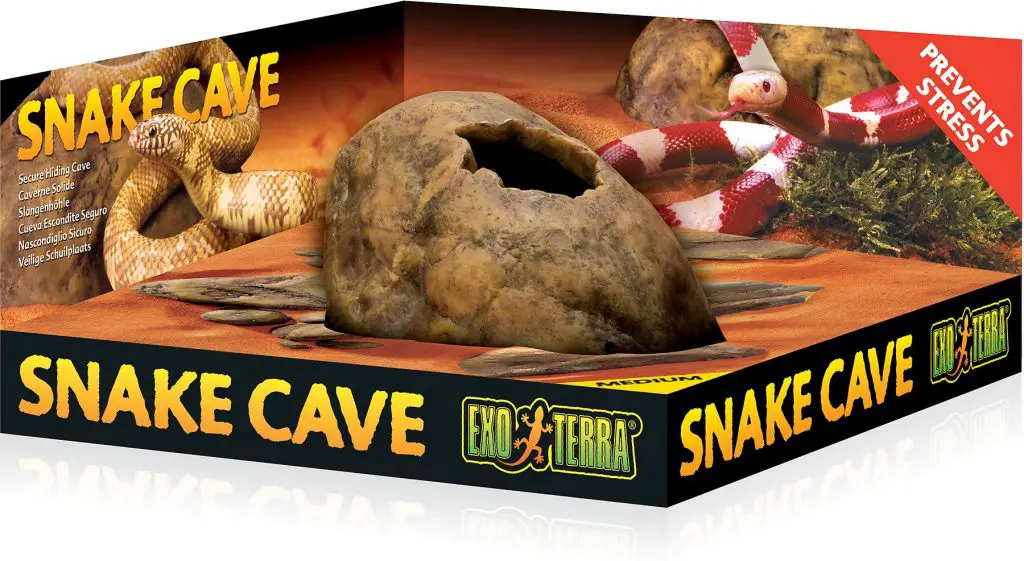
There’s a few of these products out there, not just from Exo Terra. Overall, they’re great. In fact, they have every single quality that the Exo Terra Reptile caves have.
Notwithstanding, I have two issues with them. First is that many of them are too small for adult Ball Pythons. Second is the placement of the entrance.
A lot of times my snakes skim along the ground with their nose looking for the entrance to their hideout. A lot of these cave products have an entrance in the top and my snakes would simply miss it completely!
| Pros: | Cons: |
| – Similar to the Exo Terra Reptile Caves – Attractive and naturalistic | – Expensive – Entrance placement not optimum for Ball Pythons – Don’t come in large enough sizes |
What happened when I tested them?
I’ve tried this product a couple of times over the years, and how got it is depends on your snake’s behavior. Here’s what happened:
- a couple of my snakes found the entrances to their caves and liked them just as much the Exo Terra Reptile Caves
- the rest of the snakes I gave them too completely missed the entrances. They just couldn’t find them, and did not use the caves
- when a humidity probe was placed inside, the humidity level is roughly 10% higher than the ambient humidity in the enclosure
Worst hides for Ball Pythons
There’s a few other main types of hide that regularly get sold to novice Ball Python keepers, despite that fact that they make terrible refugia for them.
- First is cork bark. This product is an excellent hide solution for most snakes, but Ball Pythons are the exception. Though you can make cork bark work for them, I have found that they are almost always happier in a cave-type hide which is enclosed on all sides.
- Second is the coconut shell hide. This is just half a coconut shell with a little doorway in it, usually about the right size for a 1- to 3-month-old Ball Python.
- Third is “stump dens”. These are usually upright hides designed to look like a log. Just like a real log, they are rough and scratchy – often resulting in scraped noses. Some of them are also reallly hard to get your snake out of!
The thing is coconut shells often come with an entrance that is too large and let’s light in. They are also less hygienic and less easy to clean than plastic or resin hides. If you have a tiny baby Ball Python that will outgrow its hide quickly, why not just use a little plastic hide instead? It’ll be more hygienic, cheaper or similar price, and need replacing just soon anyway.
As for the other, don’t even bother! Just get a good plastic or resin hide and your snakes will be happy.
The bottom line
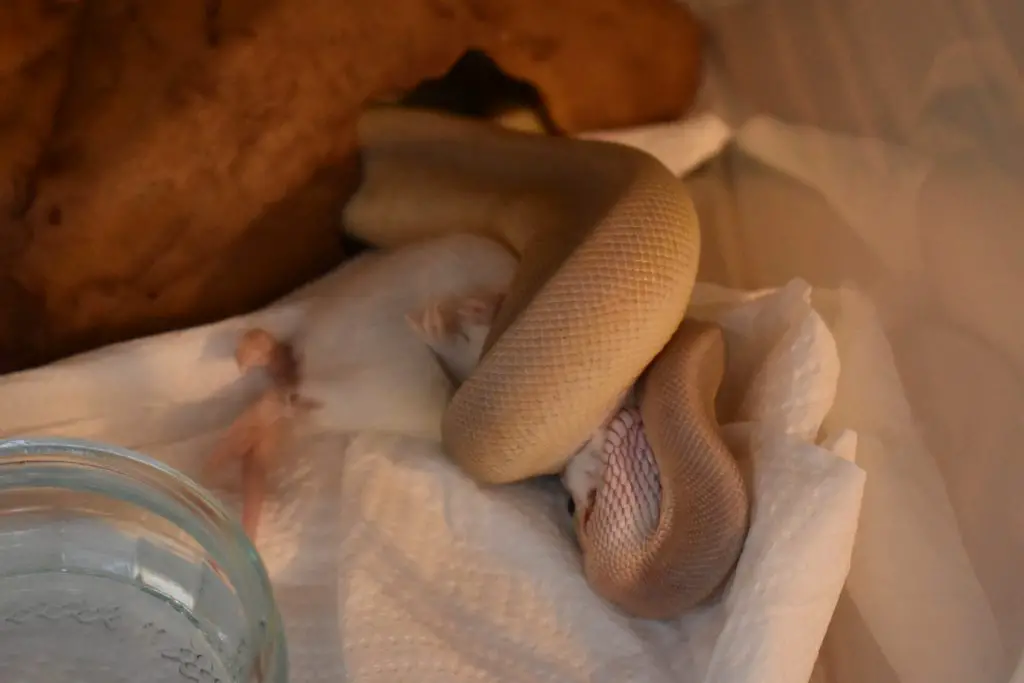
Your Ball Python’s hide is its pride and joy! It goes there to shed, sleep, digest its food, or wait in ambush.
Getting the right kind of hide can be the difference between a Ball Python that feels safe and eats great or a stressed snake that slowly becomes anorexic.
All things considered, I would recommend taking some time to select a good hide when setting up your snake’s enclosure. In general, though, resin or plastic caves are almost always the best options.
FAQ relating to Ball Python hides
Do ball pythons like tight hides?
Ball Pythons absolutely love tight hides because they are positively thigmotactic. This is a scientific term that simply means they gain reassurance from being pressed against surfaces. In the wild, it helps them avoid predators by instinctively cramming themselves tightly into burrows and hiding places.
Do ball pythons need hides?
Ball Pythons absolutely need hides to feel safe in their enclosure. Giving your snake two hides, one on each end of their thermal gradient, let’s them feel secure wherever they choose to sleep. If your try to keep Ball Pythons in open enclosures without hides they quickly become anorexic.
How big should a ball python hide be?
A Ball Python hide should only just be big enough for the snake to fit inside. If your pet is only occupying half of the hide, then it’s too big. On the other hand, if the hide is too small, you’ll that it lifts up when the snake goes inside.
Do ball pythons get stressed in large enclosures?
Ball Pythons get incredibly stressed in large enclosures. The same is true for enclosures that are too open, such as glass tanks, or enclosures that are placed in a high traffic area of the house. For this species, always place their enclosure against a wall and provide plenty of hiding places.
Also on this topic:
More on substrates and hides:
Back to the substrate and hides page.
